A Comprehensive Report on the Australian Health Care System Features
VerifiedAdded on 2021/05/27
|7
|1438
|26
Report
AI Summary
This report provides a comprehensive overview of the Australian health care system, addressing key features and challenges. It begins with an examination of the NSW chronic disease management program, detailing its principles and effectiveness in managing chronic conditions and reducing hospitalizations. The report then analyzes the advantages and disadvantages of the Medicare system, highlighting its role in providing quality care and accessibility while also identifying limitations in primary care appointments and addressing urban-rural disparities. The report continues with case studies, discussing the immediate health needs of individuals like Marcus, who requires support for type 2 diabetes management and social support, and Sita, who needs assistance in managing her recovery process. Additionally, the report explores political and social issues impacting indigenous health policy development, such as lack of equal opportunities and government commitment. It also examines interdisciplinary teams and the importance of private insurance within the Australian health system, and it concludes by discussing how to support patients in nursing homes to follow their religious beliefs.
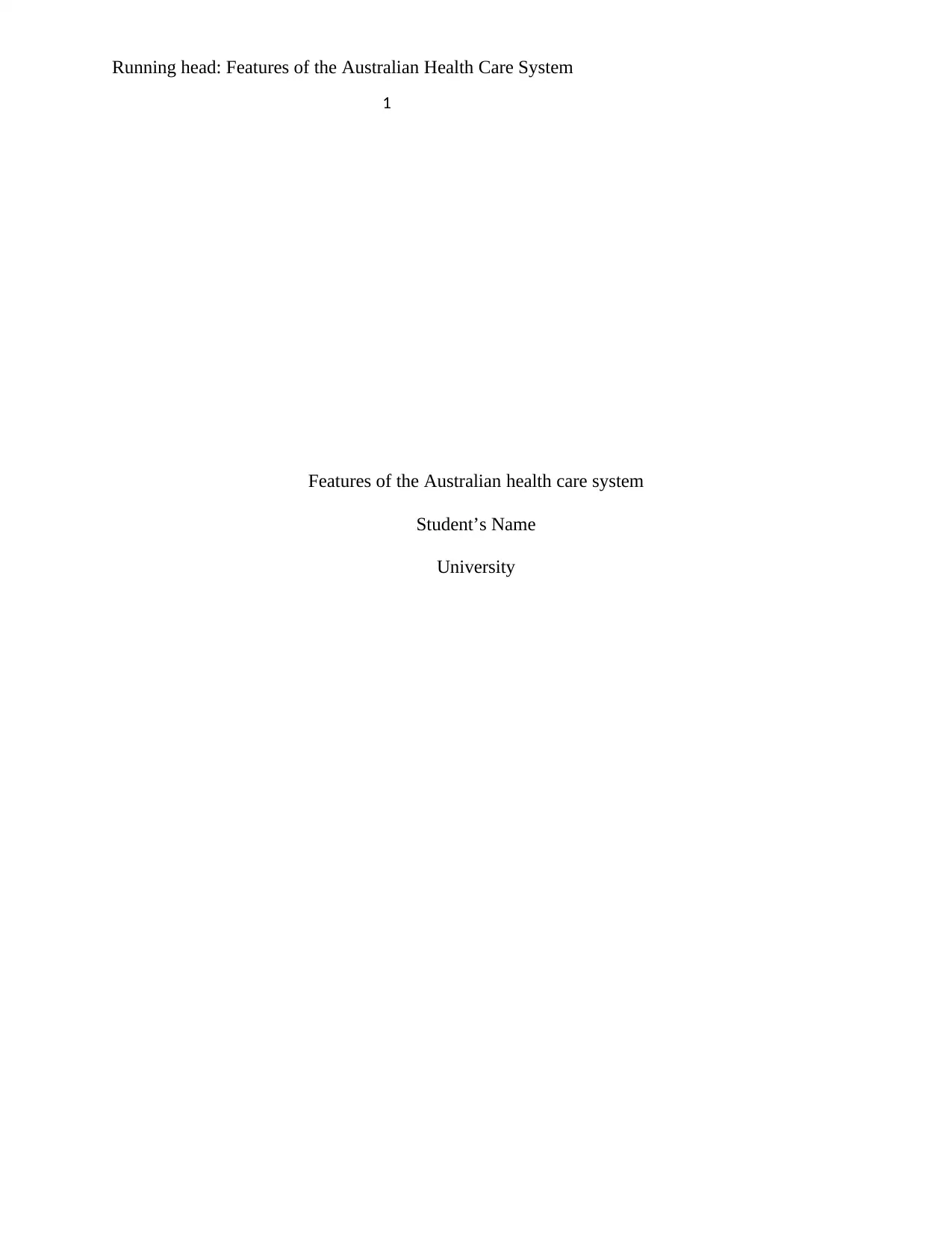
Running head: Features of the Australian Health Care System
1
Features of the Australian health care system
Student’s Name
University
1
Features of the Australian health care system
Student’s Name
University
Paraphrase This Document
Need a fresh take? Get an instant paraphrase of this document with our AI Paraphraser
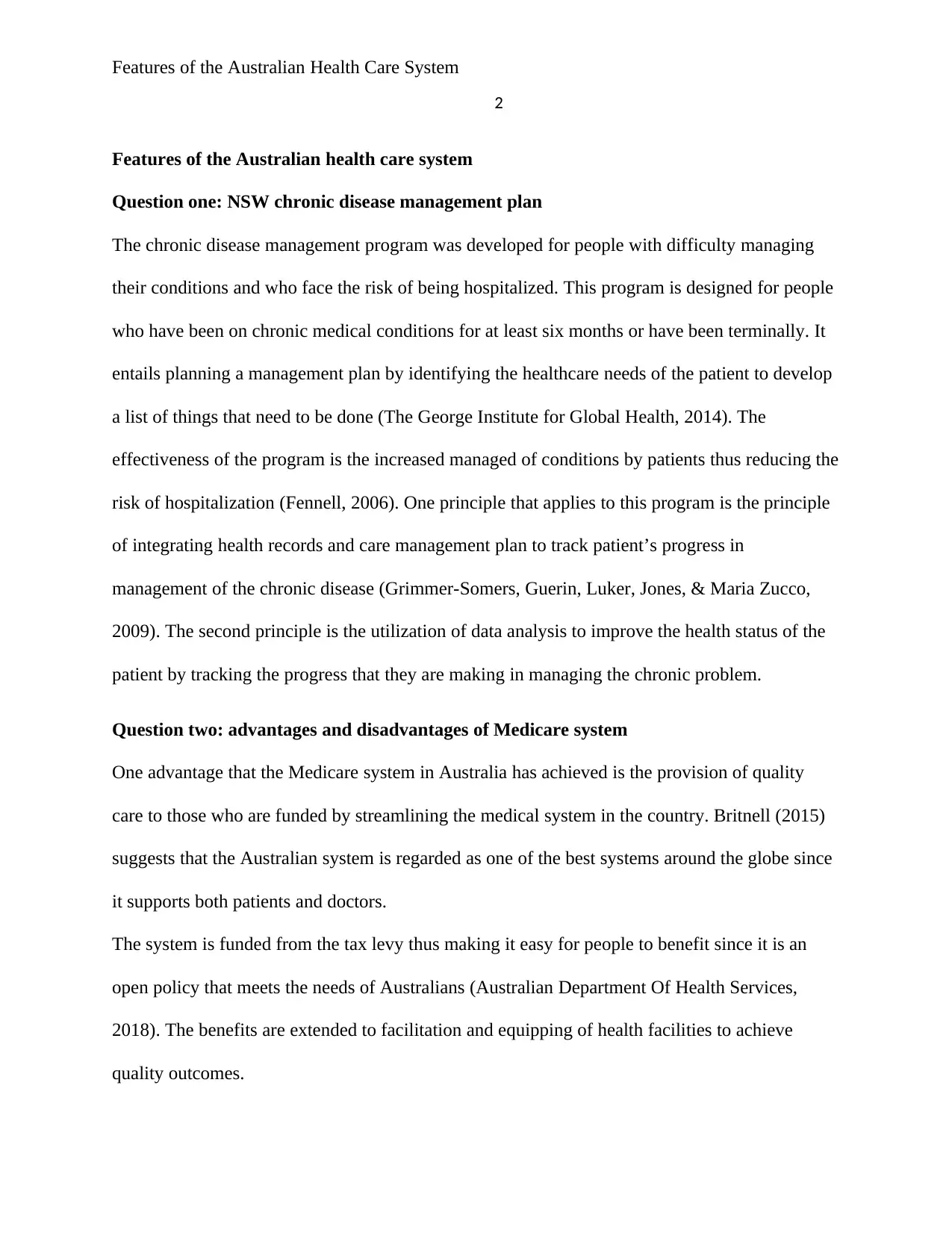
Features of the Australian Health Care System
2
Features of the Australian health care system
Question one: NSW chronic disease management plan
The chronic disease management program was developed for people with difficulty managing
their conditions and who face the risk of being hospitalized. This program is designed for people
who have been on chronic medical conditions for at least six months or have been terminally. It
entails planning a management plan by identifying the healthcare needs of the patient to develop
a list of things that need to be done (The George Institute for Global Health, 2014). The
effectiveness of the program is the increased managed of conditions by patients thus reducing the
risk of hospitalization (Fennell, 2006). One principle that applies to this program is the principle
of integrating health records and care management plan to track patient’s progress in
management of the chronic disease (Grimmer-Somers, Guerin, Luker, Jones, & Maria Zucco,
2009). The second principle is the utilization of data analysis to improve the health status of the
patient by tracking the progress that they are making in managing the chronic problem.
Question two: advantages and disadvantages of Medicare system
One advantage that the Medicare system in Australia has achieved is the provision of quality
care to those who are funded by streamlining the medical system in the country. Britnell (2015)
suggests that the Australian system is regarded as one of the best systems around the globe since
it supports both patients and doctors.
The system is funded from the tax levy thus making it easy for people to benefit since it is an
open policy that meets the needs of Australians (Australian Department Of Health Services,
2018). The benefits are extended to facilitation and equipping of health facilities to achieve
quality outcomes.
2
Features of the Australian health care system
Question one: NSW chronic disease management plan
The chronic disease management program was developed for people with difficulty managing
their conditions and who face the risk of being hospitalized. This program is designed for people
who have been on chronic medical conditions for at least six months or have been terminally. It
entails planning a management plan by identifying the healthcare needs of the patient to develop
a list of things that need to be done (The George Institute for Global Health, 2014). The
effectiveness of the program is the increased managed of conditions by patients thus reducing the
risk of hospitalization (Fennell, 2006). One principle that applies to this program is the principle
of integrating health records and care management plan to track patient’s progress in
management of the chronic disease (Grimmer-Somers, Guerin, Luker, Jones, & Maria Zucco,
2009). The second principle is the utilization of data analysis to improve the health status of the
patient by tracking the progress that they are making in managing the chronic problem.
Question two: advantages and disadvantages of Medicare system
One advantage that the Medicare system in Australia has achieved is the provision of quality
care to those who are funded by streamlining the medical system in the country. Britnell (2015)
suggests that the Australian system is regarded as one of the best systems around the globe since
it supports both patients and doctors.
The system is funded from the tax levy thus making it easy for people to benefit since it is an
open policy that meets the needs of Australians (Australian Department Of Health Services,
2018). The benefits are extended to facilitation and equipping of health facilities to achieve
quality outcomes.
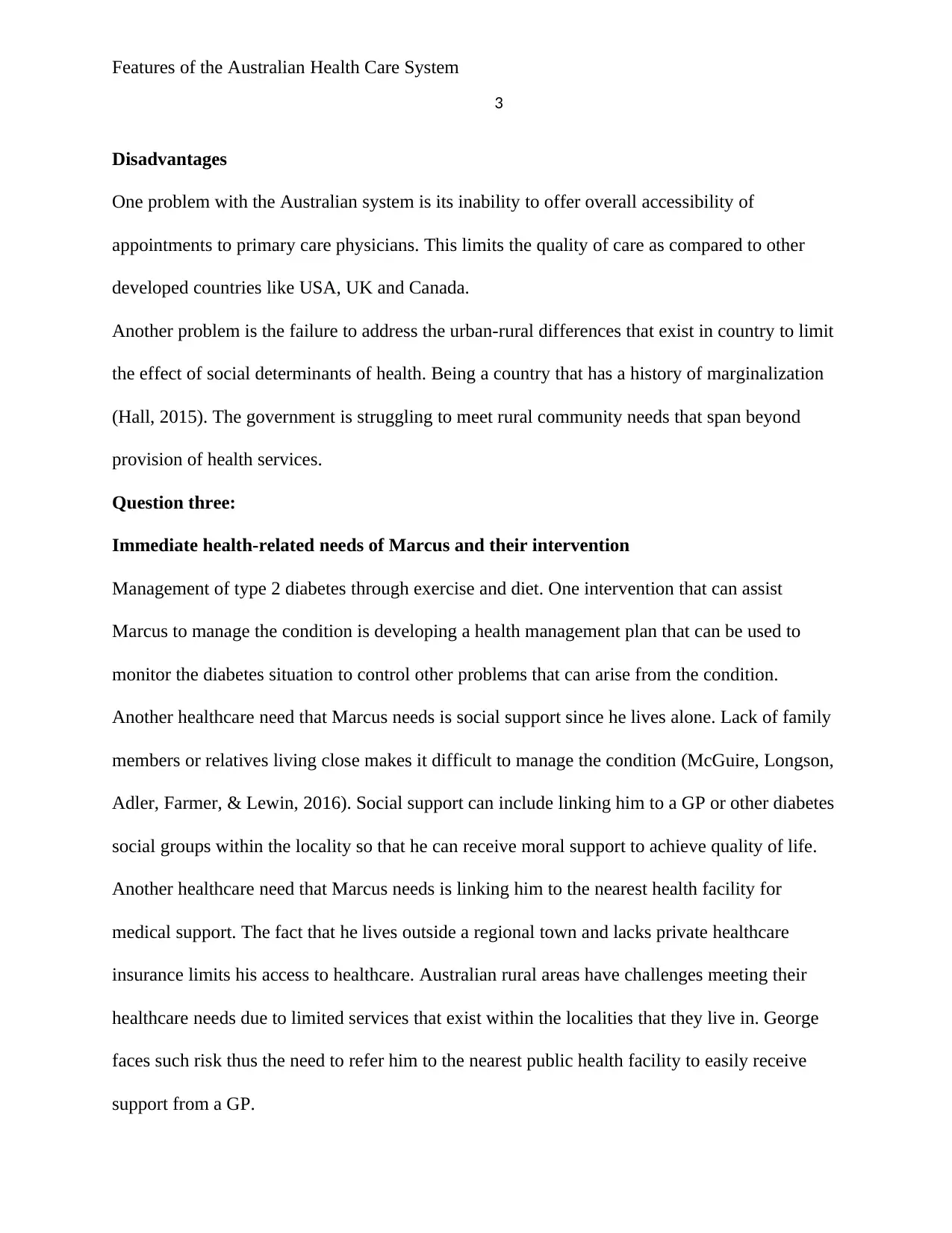
Features of the Australian Health Care System
3
Disadvantages
One problem with the Australian system is its inability to offer overall accessibility of
appointments to primary care physicians. This limits the quality of care as compared to other
developed countries like USA, UK and Canada.
Another problem is the failure to address the urban-rural differences that exist in country to limit
the effect of social determinants of health. Being a country that has a history of marginalization
(Hall, 2015). The government is struggling to meet rural community needs that span beyond
provision of health services.
Question three:
Immediate health-related needs of Marcus and their intervention
Management of type 2 diabetes through exercise and diet. One intervention that can assist
Marcus to manage the condition is developing a health management plan that can be used to
monitor the diabetes situation to control other problems that can arise from the condition.
Another healthcare need that Marcus needs is social support since he lives alone. Lack of family
members or relatives living close makes it difficult to manage the condition (McGuire, Longson,
Adler, Farmer, & Lewin, 2016). Social support can include linking him to a GP or other diabetes
social groups within the locality so that he can receive moral support to achieve quality of life.
Another healthcare need that Marcus needs is linking him to the nearest health facility for
medical support. The fact that he lives outside a regional town and lacks private healthcare
insurance limits his access to healthcare. Australian rural areas have challenges meeting their
healthcare needs due to limited services that exist within the localities that they live in. George
faces such risk thus the need to refer him to the nearest public health facility to easily receive
support from a GP.
3
Disadvantages
One problem with the Australian system is its inability to offer overall accessibility of
appointments to primary care physicians. This limits the quality of care as compared to other
developed countries like USA, UK and Canada.
Another problem is the failure to address the urban-rural differences that exist in country to limit
the effect of social determinants of health. Being a country that has a history of marginalization
(Hall, 2015). The government is struggling to meet rural community needs that span beyond
provision of health services.
Question three:
Immediate health-related needs of Marcus and their intervention
Management of type 2 diabetes through exercise and diet. One intervention that can assist
Marcus to manage the condition is developing a health management plan that can be used to
monitor the diabetes situation to control other problems that can arise from the condition.
Another healthcare need that Marcus needs is social support since he lives alone. Lack of family
members or relatives living close makes it difficult to manage the condition (McGuire, Longson,
Adler, Farmer, & Lewin, 2016). Social support can include linking him to a GP or other diabetes
social groups within the locality so that he can receive moral support to achieve quality of life.
Another healthcare need that Marcus needs is linking him to the nearest health facility for
medical support. The fact that he lives outside a regional town and lacks private healthcare
insurance limits his access to healthcare. Australian rural areas have challenges meeting their
healthcare needs due to limited services that exist within the localities that they live in. George
faces such risk thus the need to refer him to the nearest public health facility to easily receive
support from a GP.
⊘ This is a preview!⊘
Do you want full access?
Subscribe today to unlock all pages.

Trusted by 1+ million students worldwide
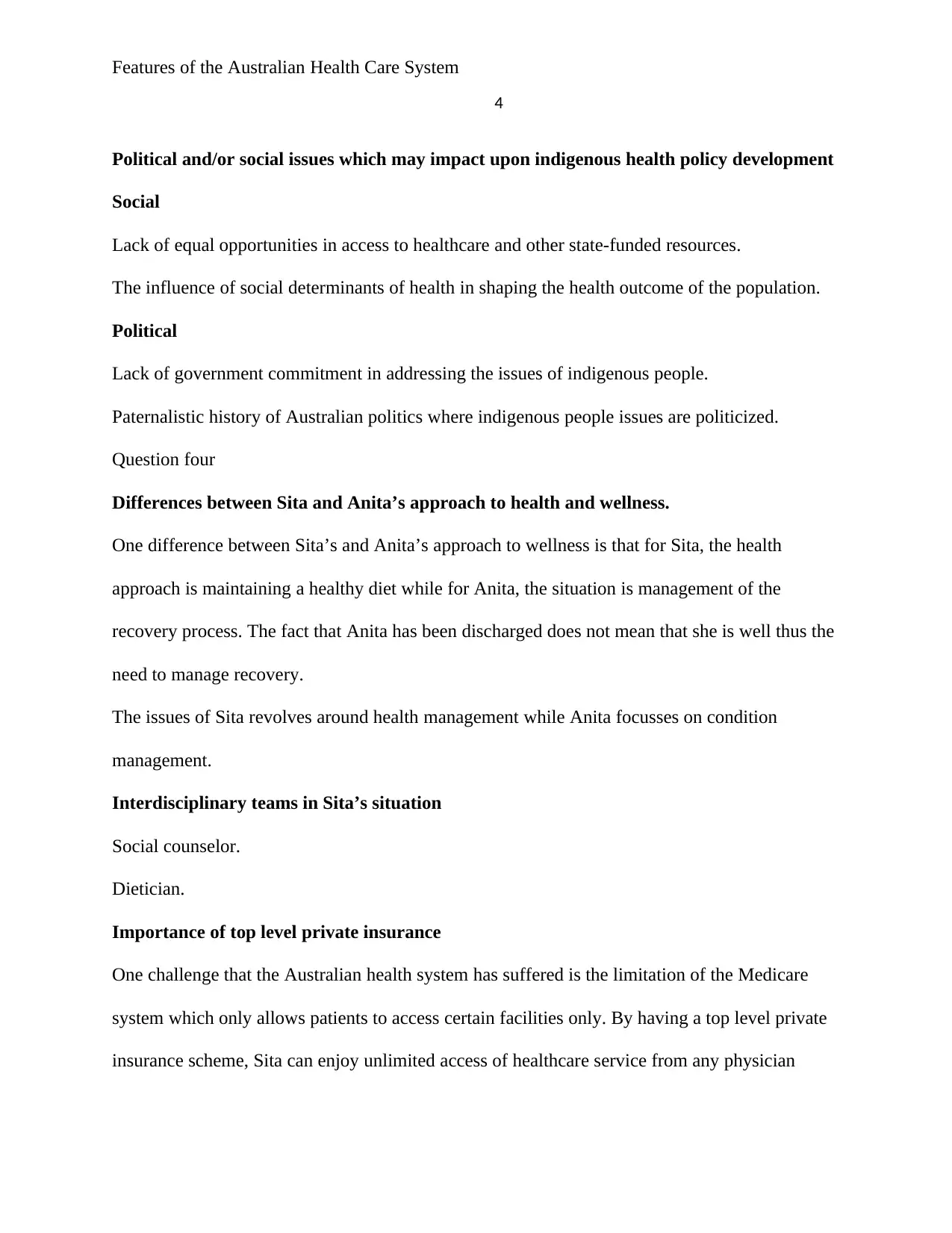
Features of the Australian Health Care System
4
Political and/or social issues which may impact upon indigenous health policy development
Social
Lack of equal opportunities in access to healthcare and other state-funded resources.
The influence of social determinants of health in shaping the health outcome of the population.
Political
Lack of government commitment in addressing the issues of indigenous people.
Paternalistic history of Australian politics where indigenous people issues are politicized.
Question four
Differences between Sita and Anita’s approach to health and wellness.
One difference between Sita’s and Anita’s approach to wellness is that for Sita, the health
approach is maintaining a healthy diet while for Anita, the situation is management of the
recovery process. The fact that Anita has been discharged does not mean that she is well thus the
need to manage recovery.
The issues of Sita revolves around health management while Anita focusses on condition
management.
Interdisciplinary teams in Sita’s situation
Social counselor.
Dietician.
Importance of top level private insurance
One challenge that the Australian health system has suffered is the limitation of the Medicare
system which only allows patients to access certain facilities only. By having a top level private
insurance scheme, Sita can enjoy unlimited access of healthcare service from any physician
4
Political and/or social issues which may impact upon indigenous health policy development
Social
Lack of equal opportunities in access to healthcare and other state-funded resources.
The influence of social determinants of health in shaping the health outcome of the population.
Political
Lack of government commitment in addressing the issues of indigenous people.
Paternalistic history of Australian politics where indigenous people issues are politicized.
Question four
Differences between Sita and Anita’s approach to health and wellness.
One difference between Sita’s and Anita’s approach to wellness is that for Sita, the health
approach is maintaining a healthy diet while for Anita, the situation is management of the
recovery process. The fact that Anita has been discharged does not mean that she is well thus the
need to manage recovery.
The issues of Sita revolves around health management while Anita focusses on condition
management.
Interdisciplinary teams in Sita’s situation
Social counselor.
Dietician.
Importance of top level private insurance
One challenge that the Australian health system has suffered is the limitation of the Medicare
system which only allows patients to access certain facilities only. By having a top level private
insurance scheme, Sita can enjoy unlimited access of healthcare service from any physician
Paraphrase This Document
Need a fresh take? Get an instant paraphrase of this document with our AI Paraphraser
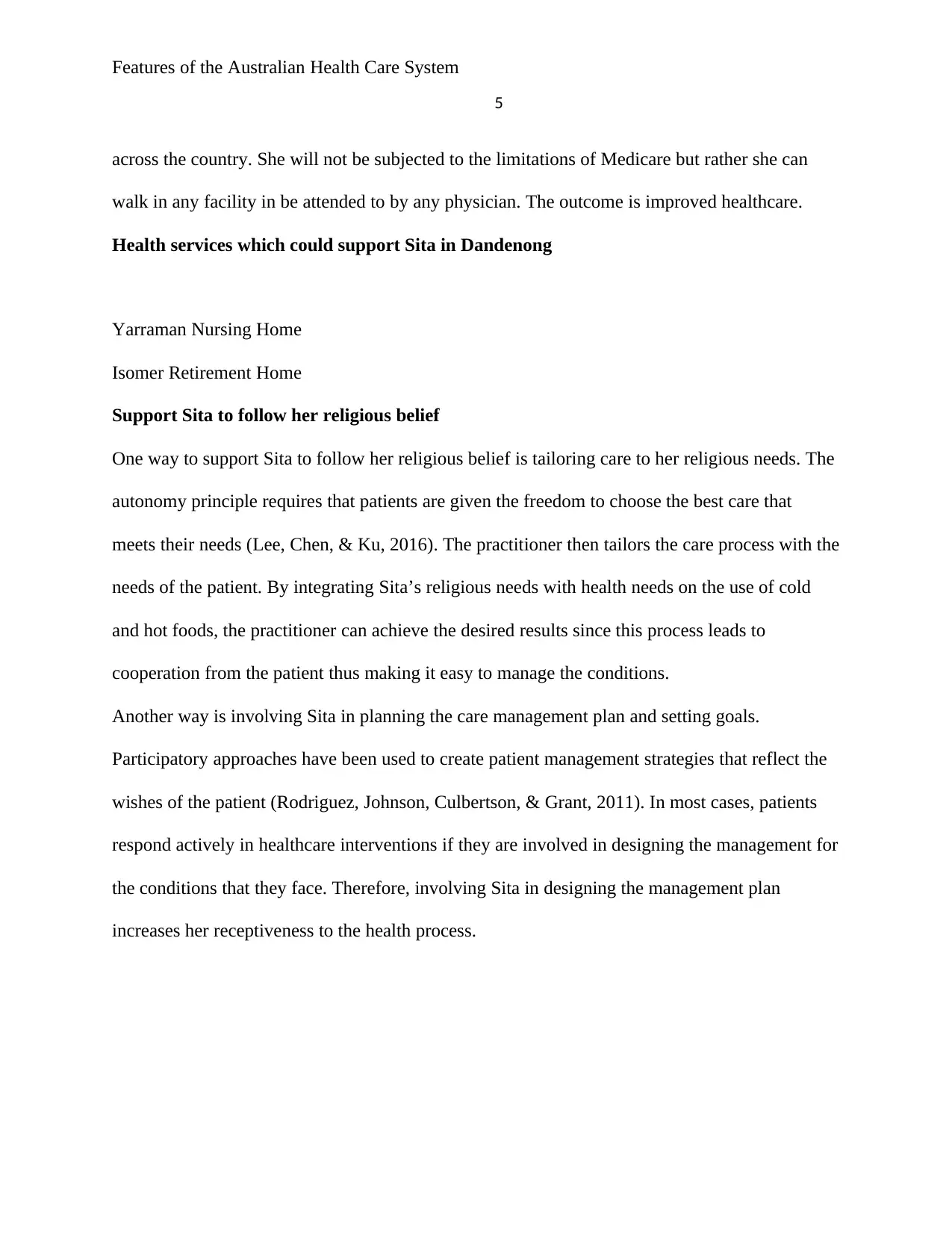
Features of the Australian Health Care System
5
across the country. She will not be subjected to the limitations of Medicare but rather she can
walk in any facility in be attended to by any physician. The outcome is improved healthcare.
Health services which could support Sita in Dandenong
Yarraman Nursing Home
Isomer Retirement Home
Support Sita to follow her religious belief
One way to support Sita to follow her religious belief is tailoring care to her religious needs. The
autonomy principle requires that patients are given the freedom to choose the best care that
meets their needs (Lee, Chen, & Ku, 2016). The practitioner then tailors the care process with the
needs of the patient. By integrating Sita’s religious needs with health needs on the use of cold
and hot foods, the practitioner can achieve the desired results since this process leads to
cooperation from the patient thus making it easy to manage the conditions.
Another way is involving Sita in planning the care management plan and setting goals.
Participatory approaches have been used to create patient management strategies that reflect the
wishes of the patient (Rodriguez, Johnson, Culbertson, & Grant, 2011). In most cases, patients
respond actively in healthcare interventions if they are involved in designing the management for
the conditions that they face. Therefore, involving Sita in designing the management plan
increases her receptiveness to the health process.
5
across the country. She will not be subjected to the limitations of Medicare but rather she can
walk in any facility in be attended to by any physician. The outcome is improved healthcare.
Health services which could support Sita in Dandenong
Yarraman Nursing Home
Isomer Retirement Home
Support Sita to follow her religious belief
One way to support Sita to follow her religious belief is tailoring care to her religious needs. The
autonomy principle requires that patients are given the freedom to choose the best care that
meets their needs (Lee, Chen, & Ku, 2016). The practitioner then tailors the care process with the
needs of the patient. By integrating Sita’s religious needs with health needs on the use of cold
and hot foods, the practitioner can achieve the desired results since this process leads to
cooperation from the patient thus making it easy to manage the conditions.
Another way is involving Sita in planning the care management plan and setting goals.
Participatory approaches have been used to create patient management strategies that reflect the
wishes of the patient (Rodriguez, Johnson, Culbertson, & Grant, 2011). In most cases, patients
respond actively in healthcare interventions if they are involved in designing the management for
the conditions that they face. Therefore, involving Sita in designing the management plan
increases her receptiveness to the health process.
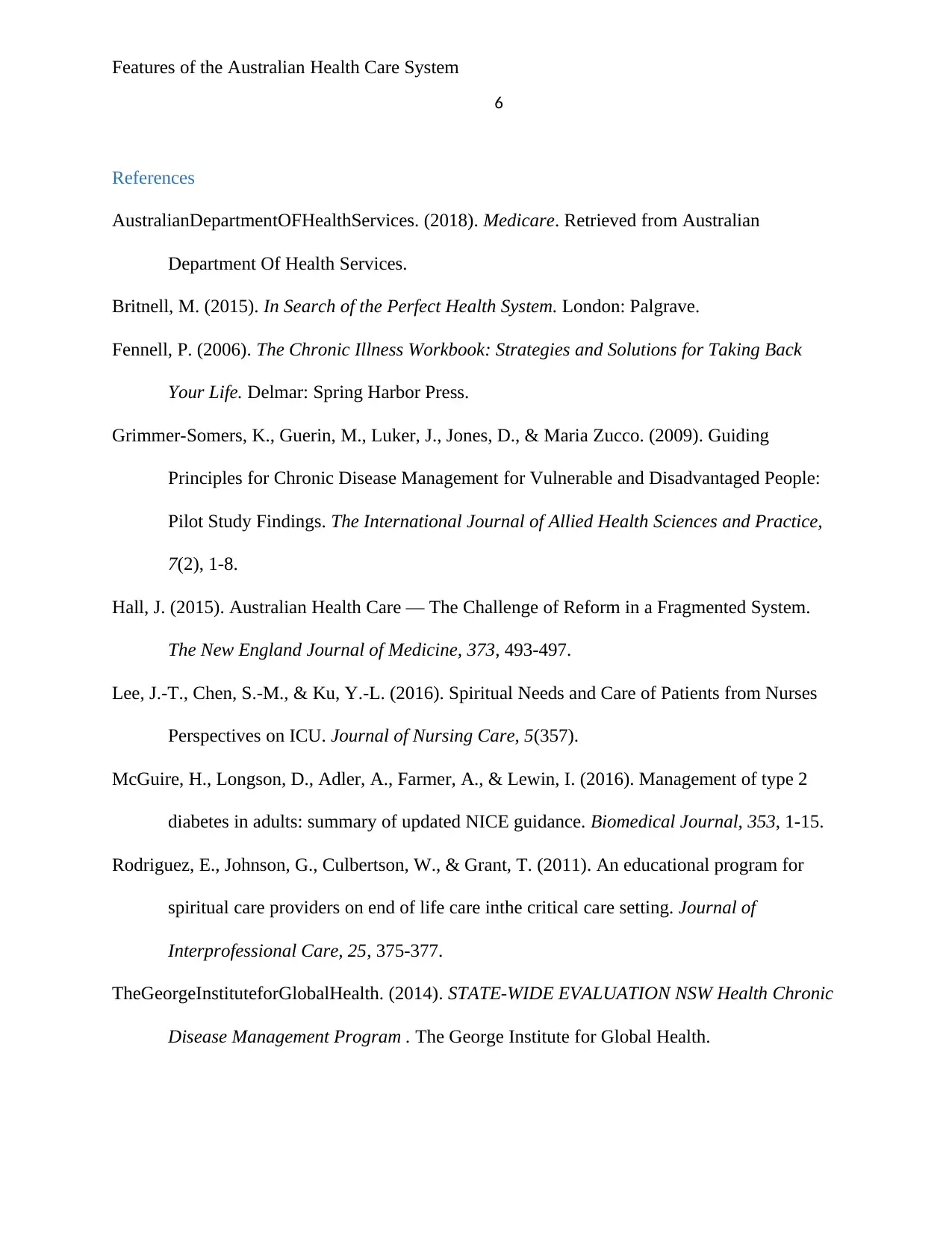
Features of the Australian Health Care System
6
References
AustralianDepartmentOFHealthServices. (2018). Medicare. Retrieved from Australian
Department Of Health Services.
Britnell, M. (2015). In Search of the Perfect Health System. London: Palgrave.
Fennell, P. (2006). The Chronic Illness Workbook: Strategies and Solutions for Taking Back
Your Life. Delmar: Spring Harbor Press.
Grimmer-Somers, K., Guerin, M., Luker, J., Jones, D., & Maria Zucco. (2009). Guiding
Principles for Chronic Disease Management for Vulnerable and Disadvantaged People:
Pilot Study Findings. The International Journal of Allied Health Sciences and Practice,
7(2), 1-8.
Hall, J. (2015). Australian Health Care — The Challenge of Reform in a Fragmented System.
The New England Journal of Medicine, 373, 493-497.
Lee, J.-T., Chen, S.-M., & Ku, Y.-L. (2016). Spiritual Needs and Care of Patients from Nurses
Perspectives on ICU. Journal of Nursing Care, 5(357).
McGuire, H., Longson, D., Adler, A., Farmer, A., & Lewin, I. (2016). Management of type 2
diabetes in adults: summary of updated NICE guidance. Biomedical Journal, 353, 1-15.
Rodriguez, E., Johnson, G., Culbertson, W., & Grant, T. (2011). An educational program for
spiritual care providers on end of life care inthe critical care setting. Journal of
Interprofessional Care, 25, 375-377.
TheGeorgeInstituteforGlobalHealth. (2014). STATE-WIDE EVALUATION NSW Health Chronic
Disease Management Program . The George Institute for Global Health.
6
References
AustralianDepartmentOFHealthServices. (2018). Medicare. Retrieved from Australian
Department Of Health Services.
Britnell, M. (2015). In Search of the Perfect Health System. London: Palgrave.
Fennell, P. (2006). The Chronic Illness Workbook: Strategies and Solutions for Taking Back
Your Life. Delmar: Spring Harbor Press.
Grimmer-Somers, K., Guerin, M., Luker, J., Jones, D., & Maria Zucco. (2009). Guiding
Principles for Chronic Disease Management for Vulnerable and Disadvantaged People:
Pilot Study Findings. The International Journal of Allied Health Sciences and Practice,
7(2), 1-8.
Hall, J. (2015). Australian Health Care — The Challenge of Reform in a Fragmented System.
The New England Journal of Medicine, 373, 493-497.
Lee, J.-T., Chen, S.-M., & Ku, Y.-L. (2016). Spiritual Needs and Care of Patients from Nurses
Perspectives on ICU. Journal of Nursing Care, 5(357).
McGuire, H., Longson, D., Adler, A., Farmer, A., & Lewin, I. (2016). Management of type 2
diabetes in adults: summary of updated NICE guidance. Biomedical Journal, 353, 1-15.
Rodriguez, E., Johnson, G., Culbertson, W., & Grant, T. (2011). An educational program for
spiritual care providers on end of life care inthe critical care setting. Journal of
Interprofessional Care, 25, 375-377.
TheGeorgeInstituteforGlobalHealth. (2014). STATE-WIDE EVALUATION NSW Health Chronic
Disease Management Program . The George Institute for Global Health.
⊘ This is a preview!⊘
Do you want full access?
Subscribe today to unlock all pages.

Trusted by 1+ million students worldwide
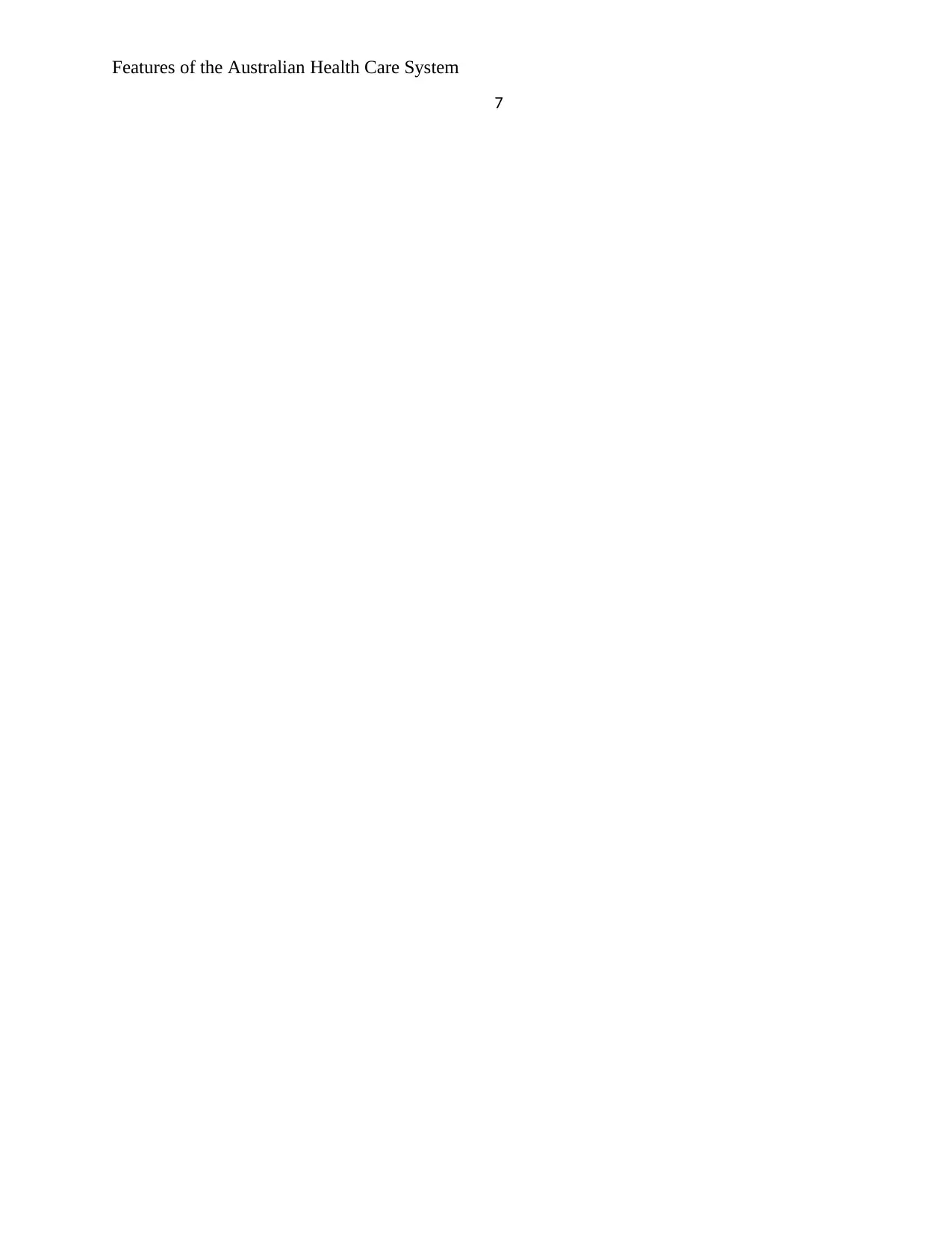
Features of the Australian Health Care System
7
7
1 out of 7
Related Documents
Your All-in-One AI-Powered Toolkit for Academic Success.
+13062052269
info@desklib.com
Available 24*7 on WhatsApp / Email
![[object Object]](/_next/static/media/star-bottom.7253800d.svg)
Unlock your academic potential
Copyright © 2020–2025 A2Z Services. All Rights Reserved. Developed and managed by ZUCOL.





